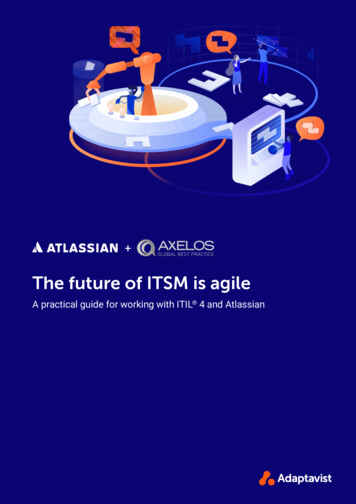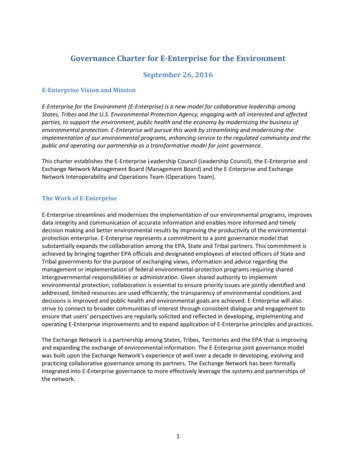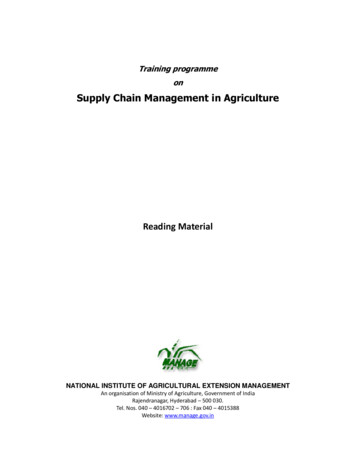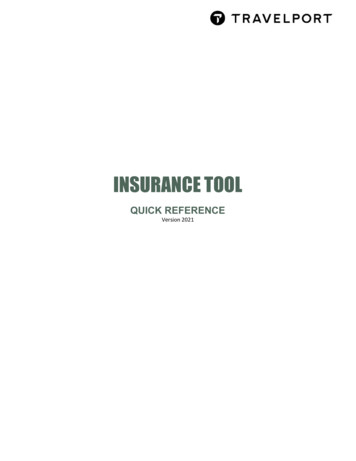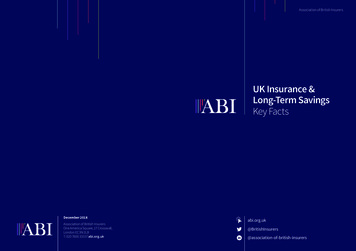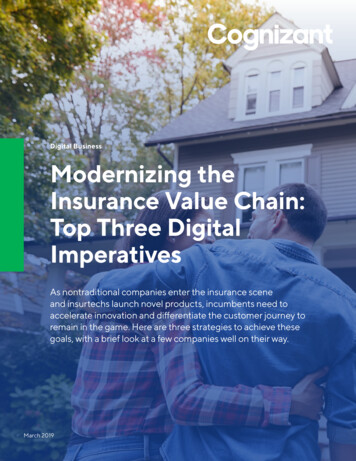
Transcription
Digital BusinessModernizing theInsurance Value Chain:Top Three DigitalImperativesAs nontraditional companies enter the insurance sceneand insurtechs launch novel products, incumbents need toaccelerate innovation and differentiate the customer journey toremain in the game. Here are three strategies to achieve thesegoals, with a brief look at a few companies well on their way.March 2019
Digital BusinessTo compete successfully in thisnew landscape, insurancecompanies are taking a fresh lookat the value chain — includingproducts, distribution methodsand service models — through adigital lens.2/Modernizing the Insurance Value Chain: Top Three Digital Imperatives
Digital BusinessExecutive SummaryA massive upheaval in the insurance industry is changing therules of competition. Incumbents face mounting threats fromnontraditional players, such as Google1 and Amazon,2, 3 whichare investing in highly targeted and digitally focused start-ups.Insurtech, which leverages artificial intelligence (AI), machinelearning and the Internet of Things (IoT), has given birth to anew class of offerings. Policies can now reflect personal drivinghabits and wearables data, and IoT sensors can help preventloss by monitoring environmental conditions like humidity andtemperature.To compete successfully in this new landscape, insurance companies are taking a freshlook at the value chain — including products, distribution methods and service models —through a digital lens. In our work with insurers around the world, the three most commongoals for software engineering, also referred to as digital engineering, are to: Gain first-mover advantage. To be first to market, insurance companies need toanticipate customer desires for products and experiences before those desires are evenexpressed. They also need the right tools, processes and infrastructure to quickly convertthese customer insights into products. Reduce legacy IT costs to fund innovation. Reducing the budget for data-centerrefreshes and legacy-application maintenance frees more funds for new productdevelopment. Grow revenue by differentiating the customer journey. Customers prefer insurers thatmake it easy to do business – for example, by issuing policies and paying claims withinminutes and making relevant, personalized offers at the right time.This white paper explores how to achieve these three imperatives through digitalengineering and highlights a few examples of progress.Modernizing the Insurance Value Chain: Top Three Digital Imperatives /3
Digital BusinessGOAL #1: Gain first-mover advantageThe first company to introduce an appealing product gains a potentiallysustainable competitive advantage.Examples of recent innovations: Rideshare insurance that allows drivers to toggle between rideshare coverage and personal coverage.5 Life insurance products that provide discounts to customers who wear activity monitors and that useconnected learning to educate customers on healthy lifestyles.6 The use of data from wearables and connected learning to reduce repeat workers’ compensation claimsby ensuring policyholders receive the proper rehabilitation to return to work safely. The deployment of home monitoring to prevent loss, by including provisions for temperature sensorsthat detect freezing pipes or fires in the absence of smoke, and floor-water sensors for early flood andleak detection.To gain a first-mover advantage, insurers need two capabilities: They must identify unmet customer needs to guide product planning. They need to swiftly adapt existing products to address market forces. For example, they couldintroduce a mobile app or modify reports to meet new regulatory requirements.4/Modernizing the Insurance Value Chain: Top Three Digital Imperatives
Digital Business Recommendations Apply human science to learn how customers would like to access your product, and identify anyexisting gaps in your current offerings. Use this insight to design new products or features that closethe gap and better align your offers or services. Build what will differentiate; buy the rest. To support the buy vs. build decision, determine the valuechain components that differentiate your offering (see Figure 1). For example, a differentiator for anauto policy might be the ability for drivers to toggle between rideshare and personal insurance, a claimsmanagement process that uses straight-through processing (STP) for faster settlements, or direct-toconsumer sales through an exchange, marketplace or aggregator. Modernize the product architecture. Deconstruct monolithic applications into microservices thatcan be swiftly snapped together to introduce and distribute new products through new channels. Alsouse microservices to build modern front ends to legacy applications, thus improving the experience forcustomers and agents.Insurance value chainModern digital engineering can provide a competitive advantage on any or all parts of the value chain.ProductManagementPolicyAdministrationand ServicingSales andDistributionMarketingNew BusinessUnderwritingand RiskManagementFinanceand AccountingClaimsManagementFigure 1Modernizing the Insurance Value Chain: Top Three Digital Imperatives /5
Digital BusinessReal-world engagement: P&C insurer modernizes legacy application to accelerate newfeature introduction and improve the user experience Challenge: A leading property and casualty insurer wanted to modernize an outdated quote-tobind application for its primary line of business. The insurer sought to add mobile access, increaseperformance and reliability, integrate the app with legacy systems and accommodate its futurepolicy admin platform implementation. Solution: Within a year, we rebuilt the application with a cloud-native architecture. We rolled it outacross multiple U.S. states using a platform as a service (PaaS) on cloud infrastructure. The technologies we used to meet the insurer’s performance goals included an asynchronous architecture,transient database and caching. To accelerate speed-to-market, we employed reusable microservices and business rules, simplified the user interface and put in place an Agile release cycle. Outcomes: 50% shorter release cycles and new feature introductions. 80% faster performance for quote-to-bind.Real-world engagement: Life insurer reaches out to millennials with product testing Challenge: The life insurance industry is stagnant; the industry faces product commoditization anda lack of relevance with younger customers. A global insurer approached us to help develop new lifeinsurance products that will drive adoption from their toughest cohort of potential buyers. Solution: Starting with a foresight lens, our team discovered a market opportunity for personalized,flexible coverage. This opportunity was dissected and presented to customers to understand thenuances of protection and risk. The resulting insights spurred ideation, and the team was able todevelop a portfolio of new product concepts. Outcomes: Product concepts were developed into preliminary prototypes for consumer testingto understand market desirability. The client has currently reengaged us to develop the supportingcustomer experience, business infrastructure/blueprint and roadmap to help realize the prioritizedconcepts.6/Modernizing the Insurance Value Chain: Top Three Digital Imperatives
Digital BusinessGOAL #2: Reduce legacy IT costs to fund innovationThe high cost of legacy IT, including infrastructure, applicationmaintenance and upgrades, can starve innovation.Moving applications to the cloud frees funds by shifting capital expense for data-center upgrades to apredictable operational expense. Application maintenance costs drop when insurance companies refactor monolithic applications into modular microservices. To add a new feature, developers can quicklyupdate just the affected microservices instead of modifying the entire application. Recommendations Develop a roadmap for gradually moving core applications and data to the cloud. To establishpriorities, conduct an application portfolio assessment that considers cloud-readiness as well as the costof moving, and not moving, to the cloud. To support the assessment, we recommend using the valuestream mapping methodology. Adopt the cloud version of existing applications. To create a distinctly branded user experience forcommercial applications like Salesforce, build a microservices-based front end. Modernize legacy mainframe and server applications by converting them to a microservicesarchitecture: Decide which applications to modernize first, such as policy management, agency distribution,compensation management or CRM, based on potential revenue lift and what the company wants tobe known for: products, service or distribution. Keep in mind that an application that costs more to migrate to the cloud, such as policy management,might also deliver the highest lift. Conversely, an application that costs less to migrate, such ascompensation management, might deliver less. Prioritize frequently modified applications, as changes can be made quickly with a microservicesarchitecture.Application maintenance costs drop when insurancecompanies re-factor monolithic applications into modularmicroservices. To add a new feature, developers can quicklyupdate just the affected microservices instead of modifyingthe entire application.Modernizing the Insurance Value Chain: Top Three Digital Imperatives /7
Digital BusinessReal-world engagement: Life & annuity insurer consolidates thousands of web portals into aunified portal with a dynamic user interface Challenge: A leading life and annuity insurer wanted a faster way to build and deploy customizedportals for its thousands of affinity groups, each of which expected a tailored experience. Theold way, creating and maintaining separate portals for each group, was too labor-intensive to besustainable. Solution: Using Amazon Web Services (AWS) core components, we built a single, unified portalwith a dynamic user interface branded for each affinity group. A common microservices layerintegrates with existing back-end services. Development took place in Agile team pods thatincluded experts in DevOps, business analysis, testing, AWS core components and Java resources.We used the Scrum framework, coding in days so that the business unit could review progressand weigh in on changes. Outcomes: 35% reduction in five-year TCO for the affinity group portals, a result of managed cloudinfrastructure and automation. Faster launches of new web portals, moving to one week from three months.8/Modernizing the Insurance Value Chain: Top Three Digital Imperatives
Digital BusinessGOAL #3: Grow revenue by differentiating thecustomer journeyIn today’s crowded market, even the most appealing new insuranceoffering will fail if the customer journey is cumbersome.Customers evaluate the experience based on: Convenience, as customers, agents and brokers like having the freedom to interact with the companyvia any touch point — mobile app, web or contact center — and to continue later from any other touchpoint, right where they left off. A fast time-to-resolution — for example, a speedy policy activation or claim payout. Relevant, personalized offers received at the right time, such as retirement products or life insuranceproducts immediately after a marriage or a child’s birth.Technologies such as electronic document capture and processing, robotic process automation (RPA)and robo-advisors improve serviceability to create a competitive advantage. Imagine differentiating yourbrand by: Paying auto-glass claims (and scheduling a repair appointment) within 10 minutes. Issuing an auto policy 30 seconds after an applicant submits a driver’s license and vehicleregistration photos. Issuing a life policy two minutes after an applicant grants access to a Fitbit or health app. Offering quote-to-buy small-business insurance that requires only the applicant’s contact information,tax ID and coverage needs. Recommendations Accelerate policy issuance and claims settlement by adopting STP. With STP, brokers or agents cancapture data and documents electronically at the start of the insurance process and then pass themautomatically to the insurer, reinsurance broker and reinsurer. Replace manual data reentry with RPA. This involves training machines to copy data from one systemto another; for example, move the value in Screen 1, Field 3 on one system to Screen 2, Field 7 on anothersystem. Eliminate human data entry to accelerate policy issuance and claims settlement from days tohours, or hours to minutes. (For more about RPA in the insurance industry, read “RPA Is Just the Start:How Insurers Can Develop a Successful Intelligent Process Automation Strategy.”)Modernizing the Insurance Value Chain: Top Three Digital Imperatives /9
Digital BusinessQuick TakeLower servicing costs withrobo-advisorsIn one of its business segments, a Fortune 500 financial services and insuranceorganization was heavily focused on high-net-worth individual accounts with dedicatedpersonal advisor services. To offset slowing growth, the company sought to also offerthe service to millennials, the vast majority of whom do not have the net worth to makepersonal-advisor services profitable.The company engaged us to recommend and cocreate a robotic advisor product. Toaccelerate product launch, the client focused on business algorithms while we focused onintegration, customer engagement and a personalized experience. The resulting roboticadvisor product helped the client: Acquire hundreds of new customers and over 20 million inassets within 60 days. Reduce the time to open an account from three weeks tothree days. Establish a pipeline of retail investors who could betransitioned to traditional managed accounts as theirassets grow and needs change.10/Modernizing the Insurance Value Chain: Top Three Digital Imperatives
Digital Business Create a seamless digital experience across the value chain — from engagement to claims.Customers should be able to use one app or web portal for everything related to their policy, fromapplying for a policy or capturing photos of damage to starting a call or chat session with the insurer.Customers who start with one channel, such as a web portal, and later switch to another channel, such asthe contact center, should not have to restate or reenter information already provided. Build robo-advisors to support customer product selection, next best action, investment adviceand other stressful decisions. (See Quick Take, previous page.)Real-world engagement: Global insurer automates low-value claims processing Challenge: To offer innovative products and coverages in a new geographic market, a globalinsurer partnered with airlines, travel agencies and multiple other distribution channels to introducea new product that offered one-click enrollment, pay-per-ride coverage and real-time claimpayments via a mobile app. With a larger customer base, the client also needed the capacity tohandle more claims. Solution: To handle the influx of low-value claims, we built an AI-based STP solution. Customersnow use a mobile app to describe the incident via text, voice or video and upload the necessaryproof. A natural language processing engine extracts needed information and then forwards itfor processing. Outcomes: Faster claims processing, moving to three minutes from more than five days. 50% more claims-handling capacity.Modernizing the Insurance Value Chain: Top Three Digital Imperatives /11
Digital BusinessLooking aheadTo compete with nontraditional market entrants — and profit from insurtech rather than lose businessto it — insurance companies need the people, processes and technology to quickly identify emergingopportunities and launch new products. We recommend that insurance companies first identify theircomparative advantage — product, experience or distribution — and then do some combination ofthe following: Modernize existing applications by adding a new interface or by making them cloud-native to reducemanagement costs and accelerate new feature introductions. Build new microservices-based applications to meet new customer needs, leveraging AI, IoT, machinelearning and RPA to differentiate the customer journey. Accelerate time-to-market by distributing new products through exchanges, marketplaces oraggregators. This will afford time to build an internal distribution channel if desired.Keep in mind that modern digital engineering does not happen in a vacuum; new products need to playwell with existing technologies and processes. Be sure that the development team has the in-depthunderstanding of legacy insurance applications and the data needed to integrate them with new, digitallyengineered products.Modern digital engineeringdoes not happen in a vacuum;new products need to play wellwith existing technologies andprocesses.12/Modernizing the Insurance Value Chain: Top Three Digital Imperatives
Digital BusinessEndnotes1“Alphabet invests 375 million in health insurance start-up Oscar,” Los Angeles Times, August 14, 2018, 0814-story.html.2Jon Russell, “Amazon leads 12M investment in India-based digital insurance startup Acko,” TechCrunch, illion-investment/.3Nick Wingfield, Katie Thomas and Reed Abelson, “Amazon, Berkshire Hathaway and JPMorgan Team Up to Try to DisruptHealth Care,” New York Times, Jan. 30, 2018, hire-hathawayjpmorgan-health-care.html.4Insurance CIO Outlook, Top 10 Insurtech Startups - 2018, /vendors/top-insurtech-startups-2018.html.5Lacie Glover, “Rideshare Insurance for Drivers: Where to Buy, What it Covers,” NerdWallet, April 2, 2018, -insurance/.6Hatham Elhawary, “Workplace Wearables etc.,” Property Casualty 360, Nov. 18, 2018, ng the Insurance Value Chain: Top Three Digital Imperatives /13
Digital BusinessAbout the authorsMichael CliftonSenior Vice President, Insurance Strategy,Platforms & Ventures, CognizantMichael Clifton leads the Emergent Business Group within Cognizant’s GlobalInsurance Practice to bring next-generation venture start-ups, partnerships andplatforms to market. He is known as a senior leader and strategist with broadexpertise in assessing operations and business challenges, developing strategiesand delivering results. Michael brings extensive experience in driving innovationand change for business transformation. He has a diverse background in theinsurance, financial services and technology industries (software and services), focused on delivering global initiativesthat align corporate targets. His specialties include IT modernization of infrastructure and legacy apps, and guidingour global clients in developing digital narratives across the value chain. Michael has worked closely with large-scaleand geographically distributed work forces to enable change. Prior to Cognizant, Michael held C-level positions atthe Federal Bank of Boston and the Hanover Insurance Group, and he founded and divested a number of start-upbusinesses. He can be reached at Michael.Clifton@cognizant.com www.linkedin.com/in/michael-clifton/.Rajesh ShastriVice President, CTO and Digital Engineering Leader,Insurance Practice, CognizantRajesh Shastri leads the Digital Engineering and Technology Office withinCognizant’s Insurance Practice. He is a recognized leader in driving technologyled transformation to achieve business outcomes such as accelerating speed-tomarket, optimizing technology investments and automating operations to reducecosts and improve the customer journey. Rajesh has led major initiatives involvinglegacy application transformation, greenfield application development and cloudenablement of insurance applications. His technical expertise includes cloud-nativearchitectures, microservices and applying digital technologies to optimize the insurance value chain. He can bereached at Rajesh.Shastri@cognizant.com ernizing the Insurance Value Chain: Top Three Digital Imperatives
About Cognizant InsuranceCognizant’s Insurance Practice is one of the largest industry verticals that partners with insurers to evolve their business and technology landscape andenable end-to-end digital transformation. Thirty-three of the top 50 U.S. insurers and seven of the top 10 global insurers rely on us to help manage theirtechnology portfolio across multiple business entities and geographies. We serve the entire range of lines of business within life, annuities, and propertyand casualty insurance. Our consulting-led approach, deep domain expertise and partner ecosystem enable clients to address the dual mandate of “optimizing the business” while “driving digital at scale.” From large-scale core system transformation to adoption of cutting-edge technologies like artificial intelligence, analytics, blockchain, automation and machine learning, we partner with insurers to envision and build the digital insurer of the future.Our partnership includes helping insurers build their own technology platform with the capabilities they need or providing one for them, incorporatingdigital solutions to achieve immediate results. Learn more at www.cognizant.com/insurance.About Cognizant SoftvisionAs part of Cognizant Digital Business, our customer-centric approach to digital product engineering leverages speed, scale and a digital DNA culture todeliver experience-based software products. We enable our clients to accelerate their digital transformation journey by developing strategies to replacelegacy systems with a cloud-native architecture. This is the first step for clients evolving from traditional into digital companies — ready for tomorrow’smarketplace. Visit Cognizant Softvision at ision-digital-product-engineering.About CognizantCognizant (Nasdaq-100: CTSH) is one of the world’s leading professional services companies, transforming clients’ business, operating and technologymodels for the digital era. Our unique industry-based, consultative approach helps clients envision, build and run more innovative and efficient businesses. Headquartered in the U.S., Cognizant is ranked 195 on the Fortune 500 and is consistently listed among the most admired companies in the world.Learn how Cognizant helps clients lead with digital at www.cognizant.com or follow us @Cognizant.World HeadquartersEuropean HeadquartersIndia Operations Headquarters500 Frank W. Burr Blvd.Teaneck, NJ 07666 USAPhone: 1 201 801 0233Fax: 1 201 801 0243Toll Free: 1 888 937 32771 Kingdom StreetPaddington CentralLondon W2 6BD EnglandPhone: 44 (0) 20 7297 7600Fax: 44 (0) 20 7121 0102#5/535 Old Mahabalipuram RoadOkkiyam Pettai, ThoraipakkamChennai, 600 096 IndiaPhone: 91 (0) 44 4209 6000Fax: 91 (0) 44 4209 6060 Copyright 2019, Cognizant. All rights reserved. No part of this document may be reproduced, stored in a retrieval system, transmitted in any form or by any means,electronic, mechanical,photocopying, recording, or otherwise, without the express written permission from Cognizant. The information contained herein is subject to change without notice. All other trademarksmentioned herein are the property of their respective owners.Codex 4334
Modernizing the Insurance Value Chain: Top Three Digital Imperatives / 3 Digital Business A massive upheaval in the insurance industry is changing the rules of competition. Incumbents face mounting threats from nontraditional players, such as Google1 and Amazon,2, 3 which are inve


